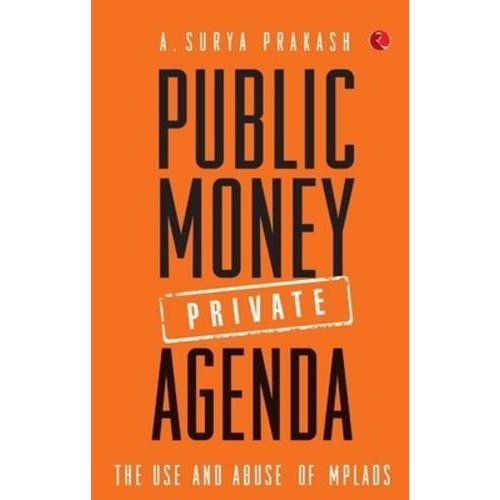Surya Prakash’s scholastic dissection of the largesse called MPLAD: Rs 20,000 crore-plus of discretionary spending that MPs do, and another Rs 40,000 crore of shadowy spending by state legislators
Public Money, Private Agenda: The Use And Abuse Of MPLADS
By A Surya Prakash
Rupa, Rs 395
In the 1970s, corporators of the then Bombay Municipal Corporation (BMC) gave themselves Rs 50,000 a year.
Their idea was that each one of them must have these monies over and above their collective control over the BMC budgets. This they could spend on works that caught their eye. (The sum today stands at Rs 10 lakh per corporator.) By the mid 1980s, members of the Maharashtra assembly got themselves a similar local area development fund worth Rs 10 lakh per year. Since then, many other assemblies have followed suit. Discretionary allocations range from Rs 1 crore per MLA to Rs 4 crore in some states. Members of parliament couldn’t have been far behind.
In January 1990, Ram Naik, a Maharashtra MP who later became petroleum minister, launched an agitation to create a similar facility for MPs. Providentially, Naik’s case for a ‘constituency fund’ was to land on the table of then finance minister, Madhu Dandvate, who was also from Maharashtra and conversant with the BMC initiative.
The plea moved quite swiftly and was raised in the appropriations bill in the Lok Sabha in April 1992 and May 1993. Narasimha Rao, the then prime minister, was much too astute to miss the ball. In fact, he grabbed it with both hands and announced at the Congress parliamentary party the scheme of Rs 1 crore for every MP.
Here on, things moved fast. The Lok Sabha’s business advisory committee wrote down the main features and parameters – the idea being that MPs must have a way to identify projects that needed immediate execution without the niceties of having to go through the agency of the district collector or district magistrate (DC/DM).
The MPs got only Rs 5 lakh apiece in 1993-94, because most of the financial year was over already. So, the Rs 1 crore fund truly came into being in 1994-95. The aggregate amount estimated for spending was about Rs 900 crore a year. The figure per MP was doubled, to Rs 2 crore, from 1998-99. With effect 2011-12 it stands at Rs 5 crore per MP, a staggering aggregation of Rs 4,000 crore+ per year (Rs 20,000+ crore if the house survives its term) adding the number of MPs we have in both houses.
Add MLALADS that has pollinated in our states, and A Surya Prakash in his book ['Public Money, Private Agenda: The Use And Abuse Of MPLADS', Rupa, Rs 395] estimates that additional sums of approximately Rs 8,000 crore+ are being spent annually (Rs 40,000 crore+ if the legislative assembly survives its term of five years).
Read with consistent dilutions in the operative guidelines (six times already!) under which spending can be done, the instances of abuse cited in this book make a serious case of social audit.
I do not wish to take the thunder away from the handsome narrative citing them, but what’s struck me is the author’s near absence of academic dogma. This emerges from Surya Prakash’s deep understanding of India’s parliamentary democracy.
Here, I’ll confine myself to echoing three key points he makes as counter-narrative to closing down MPLADS:
1. India’s elections until 1971 were conducted simultaneously for the Lok Sabha and the assemblies. Until then, the job of the MPs was to legislate – and the MLAs were left to supervise building of schools, roads, toilets, etc.
It helped that the MP and the MLAs in the area would be from the same party. This allowed MPs to live his or her higher calling in life, in a word doing a little better than running to the constituency every weekend inaugurating culverts and drains.
Elections changed after 1971, where after MPs have been expected to deliver on the same yardsticks as MLAs, often needing to compete with them for retaining their political relevance in the region.
Is the expectation therefore that MPs restrict themselves to the legislative branch, and have no visible finger in the executive delivery of physical infrastructure, an over-expectation shorn of political reality?
2. On terra firma, expectations of the electorate are different from the role MPs had been assigned under the constitution. As Surya Prakash lists down, MPs used to be happy dispensing out-of-turn HMT watches, Rajdoot motorcycles, or authorising exchange of soiled notes by the Reserve Bank of India.
But with changing times, and MLAs from rival groupings biting at their heels, MPs have made a plausible case for a bigger intervention than allocation of wrist watches.
MPLADS is just that. Coupled with this competitive landscape is the growing antipathy between the institution of DC/DM and the area MP. Both think nothing of each other. The DC/DM is left with monitoring masses of central and state-sector schemes (MP Arun Shourie once asked the Kanpur district collector to simply tell him the number of schemes he administered in the district; data that came out showed the number ran into 132!) and thus has little time to bother about what’s an immediate pain point for the MP/MLA.
On the other hand, the MP/MLA has to face a mélange of competing claims where the disbursements via the agency of the DC is too slow and cumbersome.
So, MPLADS/MLALADS offers the perfect ‘jugaad’.
3. Even as the state of people’s expectation is what it is, and the disarray in administrative mechanisms only growing, the future of MPLADS has been assured by the supreme court.
A litigant went there hoping that the court will slam down on this inherent incursion of the legislature into the executive branch.
But the court, presided by justice KG Balakrishnan, didn’t bite the bullet. Instead, MPLADS/MLALADS got a thumbs-up.
In this sort of context, where people’s grand aspirations colour the interpretation of what an MP and MLA must do for them, the only dyke can be the leader himself.
But is that possible in today’s day and age? The answer lies in an instructive story narrated by former Lok Sabha speaker Shivraj Patil, credited with kick-starting MPLADS as the presiding officer.
A well wisher of Jawaharlal Nehru was ambushed by the then PM’s constituents claiming that they won’t vote for Nehru this time. Their stated reason was that a street light hadn’t been repaired for several years.
The PM’s well wisher immediately promised that the broken lighting would be fixed. The constituents gladly promised that they’ll continue to vote for Nehru. But what when the PM learnt about the trade off? He threw a fit and he bluntly asked his well wisher as to when he gave the authority to make such promises! “I am the PM and the entire country should believe I am equally concerned about them,” Nehru declared. “Let those who are protesting about the light not vote for me.”
I doubt if a single MP or MLA has the guts to take such a pan-India view. Nor are they going to trust the DC/DM to be their political bhagya vidhatas. The only salvation therefore is to strengthen the guidelines under which such amounts of taxpayers’ money is spent. For this, all we need to do is to revert to the guidelines in their original form.

